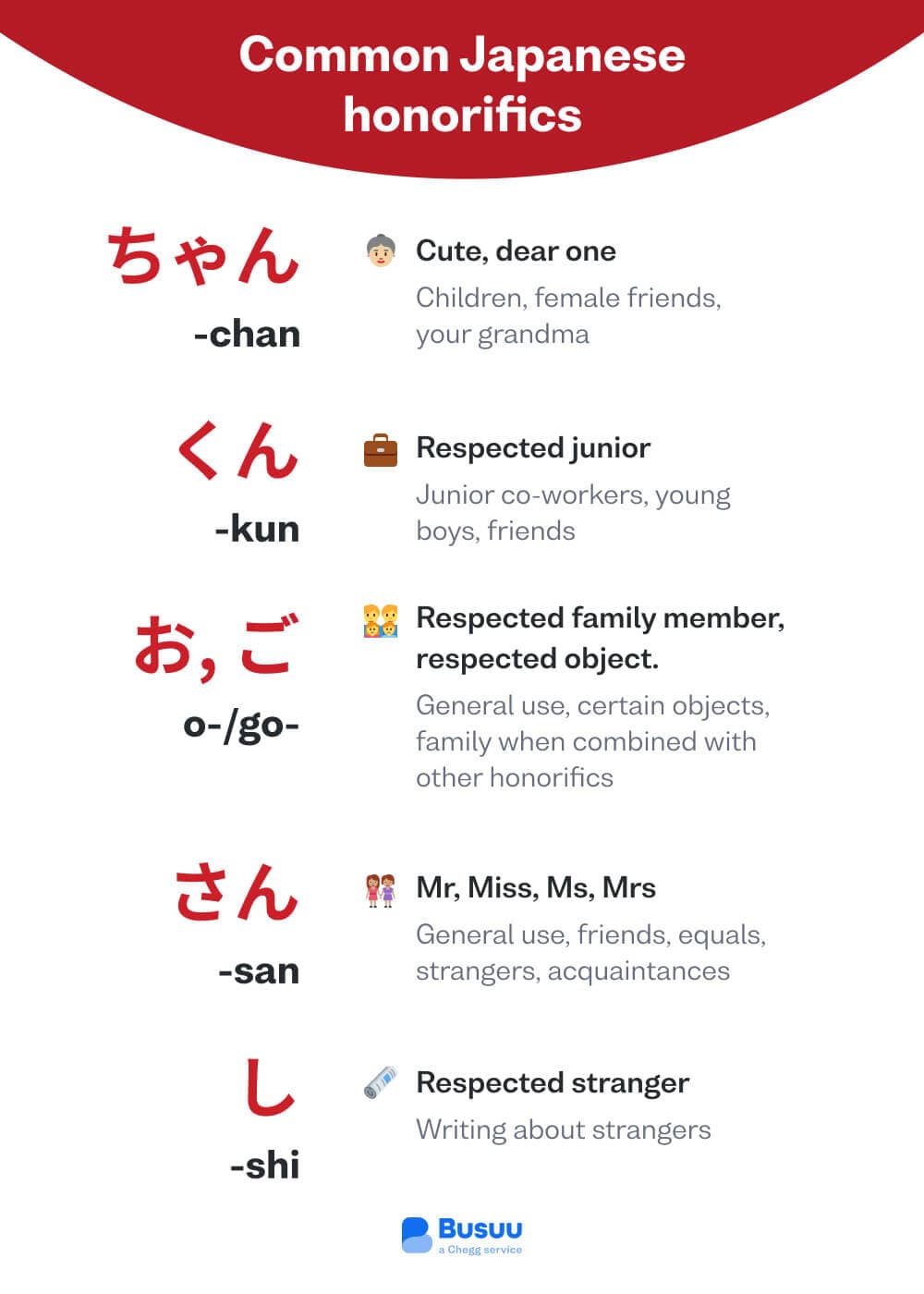I want to learn...
Japanese honorifics are complicated – and important. If you’re wondering, what do chan, kun, san, and sama mean? Well, you’ve come to the right place. In this guide to the most common Japanese honorifics added to names, you’ll learn Japanese suffix meanings so you know which one to use and when.
According to Busuu’s resident Japanese expert, “Japanese honorifics are all about politeness. They’re a little tricky, but they’re very important. See, politeness is of the utmost importance in Japanese culture, and that importance is reflected in the language system.”
Japanese honorifics, explained
Honorific language basically means more humble and more respectful ways of saying things.
It appears across several parts of speech in Japanese, including in verb variations and common phrases.
However, one common and important way honorific speech is applied is in the prefixes and suffixes we use to refer to other people indirectly and to address them directly. These additions are referred to, simply, as honorifics.
Using these honorific names correctly can make even basic Japanese feel more natural and correct to the situation – while getting these wrong can result in an awkward moment.
Admittedly, this subject can get a bit difficult as you get into more advanced Japanese, but the basics are easy enough to learn.
Top tip: When in doubt, go with addressing and referring to people using their last name plus the polite ending -san (i.e. Smith-san, Suzuki-san) until otherwise instructed.
Japanese honorifics for beginners
Honorifics are essentially nicknames that get applied across society. They’re usually suffixes and typically added to the end of someone’s last name.
The primary factors that determine which honorific you should use are:
Age
Familiarity
Social rank (for example, work hierarchy, or if one of you is royalty...)
So when speaking to an unfamiliar older person, you’d go for more polite language, while when speaking to a younger person who you know well, you’d be expected to use more casual language. It’d be oddly formal to use that polite language.
This is not an unfamiliar concept, if you think about it. We often speak to our friends differently than we speak to our boss or grandmother – the Japanese language just formalises those adjustments through grammar and honorific speech.
So, with that in mind, let’s take a look at the most common Japanese honorifics you’ll hear and use as you learn Japanese.
Chart of common Japanese honorific prefixes & suffixes

San, chan, or kun? 6 common Japanese honorific names
1. さん/-san
The Japanese suffix -san is polite, but not excessively formal.
It can be broadly used to:
Refer to anyone you don’t know, regardless of status or age
Address equals of the same age
It’s gender neutral and works functionally like Mr./Ms/Miss/Mrs., but is much more commonly used in modern language than those examples.
-San also gets added onto the names of some companies and professions to refer to the shop or the people who work there.
For example:
A butcher’s shop is called a nikuya.
The butcher themselves is nikuya-san.
Equally, the offices of a company called Big Joe’s Jeans might be referred to as Big Joe’s Jeans-san if someone were heading to visit them.
2. さま/-sama
-Sama is an other common – though less common – polite, formal suffix. It’s used to show great respect to individuals who are older or higher ranking than you.
It’s commonly used:
By businesses when referring to customers
By announcers addressing crowds
When referring to deities and divine entities
To refer to the emperor and his family
For an approximate English translation, it would be more like Sir or Madam than Mr. or Ms. – or similar to how we use, “Ladies and gentlemen”.
Notably, -sama also appears in the polite phrase said at the end of a meal in Japan, gochiso sama (deshita), the flip side of itadakimasu – both of which use honorifics to convey respect and humbleness.
Fun fact: When the current emperor's sister married a commoner, she technically became a commoner. After the wedding, Japanese news reporters switched how they referred to her from -sama to -san. (Our resident Japanese experts thought that was kind of mean.)
3. くん/-kun
The Japanese honorific -kun is common among friends and younger people.
People who watch Japanese television or read manga often take notice of -kun and -chan as they appear frequently as nicknames among friends in Japanese pop culture.
-Kun is the more respectful of the two, but is still rather informal. It’s used more commonly for men and boys than women and girls.
That said, it’s become more common for higher ups to refer to juniors at work using -kun regardless of gender and for teachers to simply use -san for everyone, regardless of gender.
4. ちゃん/-chan
-Chan, as mentioned above, is a similarly informal, familiar suffix used for people you’re close with. The more feminine nickname, it has a cutesy and childlike connotation. It takes its roots from children mispronouncing -san, but has found its way into regular use.
It is not appropriate in a work environment, but can be a nice, cute nickname for friends or romantic partners. It’s typically used for young women you’re close with, children, babies and animals, and can even be used for beloved older relatives, like a grandmother.
5. し/shi
Next, we have -shi. This is one you’ll likely use less, but may hear in use, especially on the news or radio.
The suffix -shi is used when politely referring to strangers, and is fairly formal. In news pieces, shi can also be used on its own once the person has been introduced, as long as there’s no one else it could be referring to.
6. お, ご/o-, go-
Finally, the Japanese prefixes o- and go- are common additions when referring to certain objects and nouns in polite speech.
A great example of this is お茶, ocha – cha is the word for green tea, but it is almost exclusively referred to as ocha in day-to-day Japanese. You also see it commonly used in family honorifics. For example, the word you’d use to casually address your older brother is niisan, but when being more polite or formal, it becomes o-niisan.
When should I use honorifics?
Most of the time! You can use the handy chart above to figure out which honorifics are appropriate for the situation. In fact, it’s generally considered rude to refer to someone by just their family name without an honorific in Japan, with few exceptions, even when you become more familiar. (The primary exception is athletes on the same team, if you happen to be a famous basketball player.) The act of calling someone by just their family name is called 呼び捨て (yobisute), from yobu (to call) and suteru (to throw or abandon).
Given names are generally reserved for the inner circle, but your closest friends may have you address them by their first name without an honorific.
When not to use Japanese honorific names
This is the bigger question. There are four specific cases when you should not use honorifics:
When talking about yourself – unless jokingly, and even then, tread wisely. Using an honorific for yourself makes you sound arrogant.
When talking to your family members – family members get their own honorific names, but that’s for another time.
When referring to one of your best friends/inner circle – even if you’re telling your boss about your best friend, don’t be weird about it, just use the friend’s first name like you would when talking to them. This signals to the person you’re talking to that this is a very close friend being discussed.
When someone tells you not to – if someone says yobisute to you, that means no need to use the honorific, and you’re free to oblige.
Now you know the basics of Japanese honorific names
But there’s a lot more to discover if you want to learn Japanese.
As mentioned at the start of this piece, honorific speech doesn’t end at names.
As you get further into Japanese, you’ll find that ‘honorific speech’ refers to a wide network of vocabulary. There are unique verb variations to show humbleness and different levels of respect used in everyday speech in Japan.
Honorific speech in action: common verbs
| Infinitive | Polite form | Respectful | Humble |
|---|---|---|---|
| To come | くる kuru | きます kimasu | いらっしゃる irassharu |
| To eat/drink | たべる/のむ taberu/nomu | たべます / のみます tabemasu/nomimasu | めしあがる meshiagaru |
| To say | いう iu | いいます iimasu | おっしゃる ossharu |
How useful is honorific speech, really?
Well, while this concept may seem unfamiliar and ergo unlikely to be useful, it’s actually incredibly common to see these words in use in daily life in Japan. There are tons of common Japanese words and expressions that come from these more polite forms.
For example, the phrase that’s said before starting a meal – いただきます( itadakimasu) – is from a humble ‘to eat’. What you hear when you enter stores and restaurants – いらっしゃいませ (irasshaimase) – is from a respectful ‘to come’. And when you hear people say もしもし ( moshimoshi) on the phone? That comes from a humble ‘to say’.
And there you have it! That’s Japanese honorifics explained. Now you know a bit about san, chan, kun and how to use them. But learning doesn’t stop here.
Polite speech is used widely in day-to-day Japanese, and it’s important that you take the time to master it as you learn Japanese.
You can do it, but you’ll need a good guide. Why not let Busuu light the way?
Newlanguages


